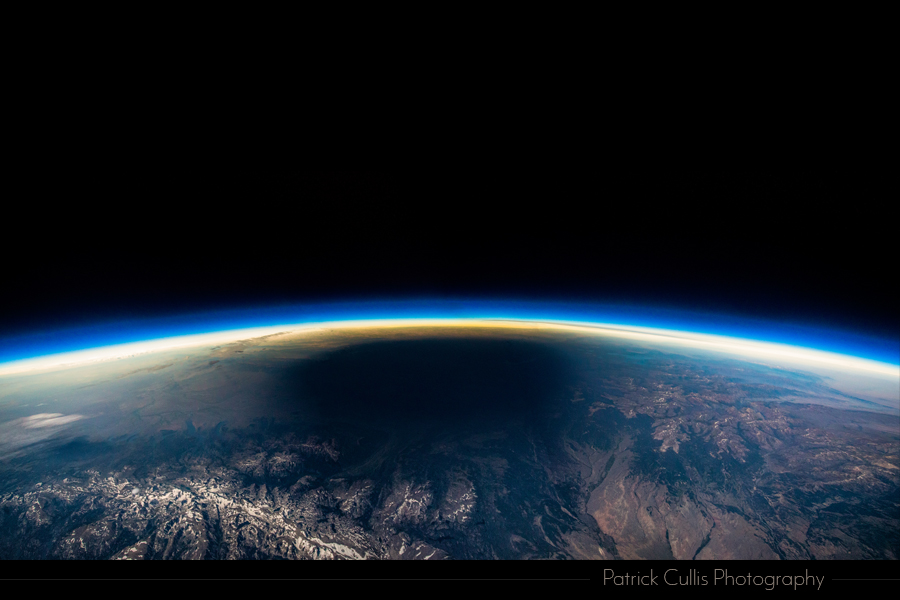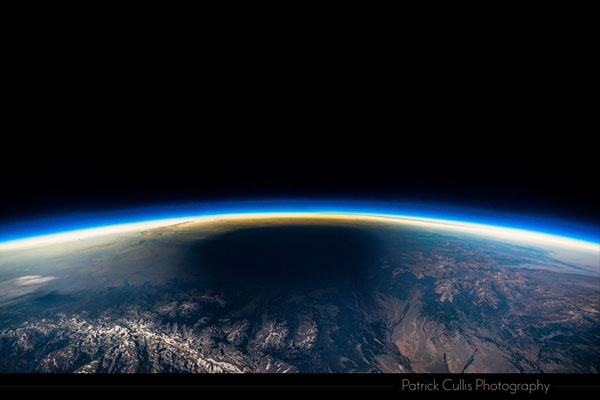Witnessing a total solar eclipse is an incredible experience. When the moon passed between the Sun and Earth on August 21, 2017 a group of friends were ready in the wilderness of Wyoming to experience the rare alignment. Along with computerized cameras on the ground, they also launched video and still cameras on a balloon to 100,000 feet to capture views of the shadow speeding across the mountains of Wyoming.








<
>
Total Solar Eclipse - Stacked image of 16 exposures from 1/8000 to 4 seconds
Shadow of the Eclipse
The "Diamond Ring"
Solar Prominences during a total eclipse
The Eclipse and Earth
Filling the balloon
Camera and telescope setup for the eclipse
Waiting for totality








For three years we had talked about the next total solar eclipse that would be happening in the United States and kicked around plans for launching my cameras on a balloon in order to capture the sight from high in the stratosphere. One benefit of way-too-much camera gear is that eventually some pretty decent gear moves down in to your "expendable" arsenal. It was pretty common to launch small action cameras like GoPros on high altitude balloons, but for the still shot I wanted, I would need to step it up a level. A year out I began plotting out the specific flight, looking at historical flight trajectories, ascent rates, and weighing everything.

As the event got closer and closer, I narrowed down my flight package. The FAA regulations can be difficult to follow when you first try reading them, but from my job I had somewhat turned in to the expert on two subjects: A) Rules and regulations regarding free flying and tethered balloons, and B) Regulations concerning international shipment of lithium batteries. In the end I had to drop the lens I really wanted to fly, and pull all of the waterproof housings off the secondary cameras in order to come in under the weight restrictions for a single flight package.
Ten days out the weather models started publishing predictions for the day of the eclipse. I was ready to head anywhere from west of Kansas City all the way to the Oregon coast. During that summer, pretty much all of Oregon was on fire, sending smoke across all of the western states. I also started to get an idea of where the camera would be flying on the day of the eclipse. It looked like it would probably head around 50-100 miles northeast from wherever the launch occurred. I knew that would change as the day approached and the models got better, but I started looking at spots along the centerline that had an easy recovery downwind. Once you let go, you don't have any control over where the balloon goes.

My initial plan was obviously to try and photograph the shadow with the Grand Tetons. They are the most iconic mountains in Wyoming and an obvious choice as my subject. But, I also thought a lot of people would be heading towards the Tetons and there are not many corridors to choose from in Wyoming. One of my earliest campsite possibilities was actually 50 miles east of the Tetons, on the other side of the Gros Ventre on top of Union Pass, a dirt road that crosses the high alpine between Dubois and Pinedale. Spending long hours on Google Earth looking at satellite images, I found a spot I thought we could reach and set that as our default campsite. Union Pass is circled by some pretty large mountain ranges and I knew the chase could end up pretty difficult, but I had done a lot of flights in the past and knew I could get anything eventually if I just had a good last location. I also wanted to keep the visual experience as the primary plan since this would be my first total solar eclipse. Photographing the event would remain secondary priorities.


In the final couple of days, the forecast really started looking bad for Wyoming. I started scouting spots in the national forest north of Boise and the desert of eastern Oregon. Thankfully, the prediction turned around and we pulled the trigger on our original spot.

Once we committed on the location, there would be no further adjustments. We also knew that traffic would get exponentially worse the closer the eclipse approached, so we left 36 hours early and drove through the night so that we would have an entire day to secure our campsite.


We passed large groups of campers up on the pass. Some spots had over a dozen cars and arrays of telescopes set up. But at the end of FS637 the spot I had picked out was empty and we set up camp. I set up my telescope tracking mount and tested out camera gear that would be used to capture the progression of the partial phase. I had downloaded a program that would cycle my cameras through a script of exposures ranging from 1/8000 all the way to 4 seconds.

Going from the script I had planned out for the past couple of months, we started filling the balloon with helium, started up the radio transmitter, and I verified that all of the cameras were ready and functioning. We let it go right as the partial phase was beginning and then sat back to enjoy the once in a lifetime event.




On the ground I had my telescope tracking mount holding my 400mm telescope and two cameras that would cycle through 60 exposures during the 2 minute event. Exposures ranged from 1/8000th of a second for the Bailey's Beads and inner corona, and 4 seconds would capture the face of the moon itself. All I had to do was remove, and place back on, the solar filters. I wanted to spend every second of totality with my full attention on the experience.
I have seen several partial eclipses but the anticipation for totality was off the charts. Around ten minutes from totality I really started noticing the temperatures and the crazy shadows. And then totality.

Most astronomical events take patience and concentration. Long hours at the telescope staring at Jupiter, building a type of muscle memory on the cloud bands until you can tease out a new detail. Saturn and its glorious rings are the best go-to subject for a first time viewer, but even they don't cause awe in everyone. Totality needs no introduction or previous experience. Photographs do not do it justice. It is a sensory overload and I cannot wait to see my next one.


After it was over, and the cheering died down, I eventually took the time to see where the balloon was when the shadow moved across the state. The balloon was at 72,000 feet during totality, but it continued up to over 100,000 feet before bursting and coming back down on a parachute. When the balloon burst, one of the meteorological radiosondes lost GPS lock and no longer knew where it was. The secondary tracker was locked on, but its battery voltage began dropping very low and then shut down still 50,000 feet above the ground. The night before got below freezing high up on the pass and I did not properly store the batteries to keep them warm. Thankfully, it was around this time that the primary tracking unit came back, but not without problems. Throughout the remainder of the descent, the GPS was jumping by thousands of feet in all three dimensions. With the extreme terrain, poor line of sight, and malfunctioning data, the cameras disappeared while still 3,000 feet over the Wind River Range.

The next day we hiked up to where the last points were reported but the terrain was difficult and we couldn't find anything. A week later we returned to search again but still with no luck. Then the weather turned bad and snow fell, ending the search until the following summer.
Throughout winter I would return to the flight data. I tried to figure out where the balloon was heading and which of the data points were good.

A breakthrough came nearly nine months later when we discovered that we could filter the latitude and longitude of the GPS data by using the GPS and Geopotential altitudes. Geopotential altitude is calculated using changes in pressure, temperature, and relative humidity and we trusted them more that the GPS. Using that, we realized that there was a connection between a jump in altitude and the corresponding jump in horizontal location.

Using the newly cleaned data, and modeling a flight trajectory through it, we had the best prediction yet of where the cameras might be. I just needed the weather to cooperate and time off work to make the 16 hour round trip drive. Finally, after several weeks of rain and then wind it all came together and I made the trip.


I drove up to Wyoming with the plan for one night at the trailhead and another up on the ridge with two days of search.

From the trailhead, it was seven miles and 3,300 feet up to the ridge where I would make camp and then start my grid search of the nearly 50 acre target area.

The yellow circle above is 50 acres which we felt confident the package had landed in. In my mind I imagined this trip being an annual occurrence as I built up a "heat map" of the area and where I had already searched. As I made my way up, I imagined how I would react if I ever did find it.


Finally through the switchbacks and above treeline, I made my way over to the target area and began looking for somewhere to drop my pack for the day. Approaching the area I saw a large dead tree I picked as a good landmark and started towards it when I stumbled right upon my goal...



I was so thrown off when I stumbled up on the white Styrofoam box that I thought I had randomly found a different meteorological balloon. Then realization washed over me and I knew that I had actually found my camera ten months after launching it in to the shadow of the eclipse. Since it was only 10AM I turned around and headed the 7 miles back down the trail to the car.

The pictures blew me away and were better than I had ever imagined. The detail in the dim partial phase was better than I had ever seen before and I was so happy with the video from the GoPro.
Shadow of the Eclipse Movie
Photography by Patrick Cullis
Music by Chad Parsons
Special thanks to Emrys Hall and Chance Sterling for their help getting the balloon off the ground while I was a mess of nerves and anticipation, and to Allen Jordan for pulling every helpful piece of data out of the digital ether in order to point me in the right direction to find it. Without all of them, this would not have been possible.
Fly-in graphic from Google Earth Pro with eclipse overlay by Xavier M. Jubier who has many excellent resources on eclipse planning and viewing.
xjubier.free.fr/en/site_pages/Solar_Eclipses.html







